|
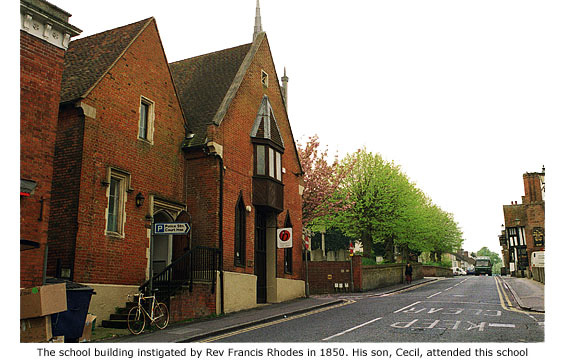
Like most towns in the 13th century, Bishop's Stortford probably had a school of some kind – usually called a Grammar school – where boys were taught by secular priests. The Church at that time related to its congregation in Latin, and schools were the base at which it was taught. No school could be opened in any diocese without the consent of the bishop.
In 1200 the Council of Westminster ordained that 'priests shall keep schools in the towns and teach the little boys free of charge. Priests ought to hold schools in their houses and if any devout person wished to entrust his little ones to them for instruction they should receive them willingly and teach them kindly. They ought not to expect anything from the relatives of the little boys except what they are willing to give'.
In 1181, a Master Richard of Stortford was the 'master of the schools in London' – the school at St Paul's being endowed by the Bishop of London. Evidence of a similar school in Bishop's Stortford is apparent from churchwardens' accounts of 1431–1440, when it was recorded that 'no rent had been received from the two messuages of the church next to the churchyard i.e. the school and the gate-house because they are dilapidated and stand empty through default'. The reason for this may well have been the plague or simply neglect by the bishop, rector or vicar. Whatever the reason, 'neglect' of schools wasn't just a local issue.
A petition of the Commons in 1447 asking for additional schools in the City of London, made the point that great numbers of Grammar schools throughout the realm, as well as in London, were now very few.
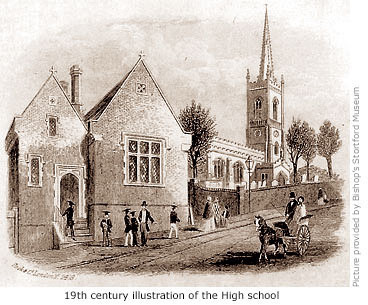 The dilapidated school and gatehouse referred to by churchwardens' was very likely a Church School, built in the mid 14th century on, or close to, the corner of Church Street and High Street and adjoining the churchyard. The dilapidated school and gatehouse referred to by churchwardens' was very likely a Church School, built in the mid 14th century on, or close to, the corner of Church Street and High Street and adjoining the churchyard.
The foundation of the town's 17th century Grammar school is generally attributed to the bequest of Margaret Dane, wife of William Dane a wealthy London merchant of the Company of Ironmongers', who was born in Bishop's Stortford in 1517. When William died he left £50 for the setting up of a school for the children of poor men and widows of the town. His hope was that it would be established within two years of his death, but no evidence exists to say if his wish was fulfilled.
When Margaret Dane died in 1579, she bequeathed to the Ironmongers' Company £2,000 to be used for benevolent purposes. This included £5 to be given annually to assist with the maintenance of a school to be built in Bishop's Stortford. If a school wasn't built the money was to be used for the relief of the poor of the town.
Shortly after administration of her will the sum of money was paid to a school, described as the Grammar school, and subsequently paid until its closure in the late 18th century. Churchwardens' accounts of 1591 refer to 'the mending of formes wher the boyes sit', and the following year 'for Glasing the schole lofte vis. 5 1/2d', i.e. the replacement of lattice windows with glass windows. Whether or not these repairs were made to the original school or to a new building is unknown, but it was probably Margaret Dane's 'maintenance' money that was used for the purpose.
AN ACCOUNT OF WILLIAM AND MARGARET DANE IS GIVEN AT THE FOOT OF THIS PAGE
Little is known of what happened to the school next, but there is certainly evidence that, from the 17th century, a school at Bishop's Stortford successfully prepared many boys to go on to Cambridge University.
The headmaster at this time was Thomas Leigh, and under his control the school flourished, attracting many boys from neighbouring counties. He also founded an excellent school library for which one of his former pupils, Sir Henry Chauncy, rated him one of the foremost benefactors of Bishop's Stortford. Leigh had made it customary for every boy who left the school to present a book to the library, which subsequently grew into a large collection. By now the school's popularity was such that the Trustees agreed to enlarge the building and also accommodate a Latin school and a Writing school. The growing library was to be housed in a separate building attached to the Grammar school.
Leigh held the position of headmaster for an incredible 47 years, but when he retired in the mid 1660s the school went into rapid decline. Future headmasters, including Leigh's second son the Rev Thomas Leigh (vicar of St Michael's 1680-86), achieved moderate success in sending boys on to University, but within 50 years the building and its ever-growing library were virtually in ruins. Not until the next century did the school attain the high standard previously set by Leigh.
In 1690 Dr Thomas Tooke, rector of Lambourne in Essex, arrived in Bishop's Stortford to fill the post of headmaster and quickly set about re-establishing the school. But two years later a review of the charities by the commissioners found that several funds meant for education and the relief of the poor had been misapplied for a number of years, much of it finding its way into the pockets of some of the most respected members of the town. They promptly appointed a new body of Trustees to administer the funds – that would include an income for the schoolmaster – and aroused new interest in the school library. The number of books by this time was well over 1300 with a value in excess of £300 but, sadly, no one had ever been appointed to look after them and their condition had deteriorated considerably.
Tooke approached his task with great enthusiasm, but when the existing school premises proved inadequate for his needs he launched an appeal for a brand new Grammar school and library. Townspeople and Gentry reacted favourably, a driving force behind the rebuilding being Edward Hill Denny (son of Edward Denny senior – See Guide 10) who subscribed generously.
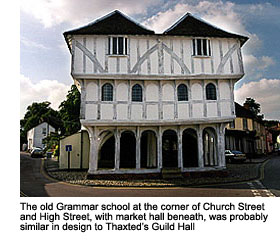 The town was also badly in need of a new market place at this time, and so a scheme sanctioned by the commissioners was put forward that would serve a dual purpose. In 1699, preparations were made to construct Wheathill Market House on the site of the old school at the corner of Church Street and Wheathill (now High Street). The ground floor was to house market stalls and shops while above them, raised on wooden arches, would be the new Grammar school comprising of three rooms – the school overlooking Wheathill (High Street) and a Writing school and library positioned on the opposite side of the building facing south. The town was also badly in need of a new market place at this time, and so a scheme sanctioned by the commissioners was put forward that would serve a dual purpose. In 1699, preparations were made to construct Wheathill Market House on the site of the old school at the corner of Church Street and Wheathill (now High Street). The ground floor was to house market stalls and shops while above them, raised on wooden arches, would be the new Grammar school comprising of three rooms – the school overlooking Wheathill (High Street) and a Writing school and library positioned on the opposite side of the building facing south.
But the sum of money raised for the school soon proved insufficient and a second appeal was launched. The original contributors donated extra funds, but only on the condition that the townspeople 'for whose benefit and interest the school was being built' also subscribed towards finishing the work. This they did, and around 1709 the building was completed.
The new school flourished just as the old school had under Leigh, the number of pupils in attendance so great that a gallery had to be constructed in St Michael's church to accommodate them all for services. Dr Tooke was acclaimed by many including the author and political writer Daniel Defoe who, on a visit to Bishop's Stortford around 1710, described the town as 'large and well built whose greatest ornament is the school'.
Further endorsment came from John Edwin Cussans (1834-1899) who in his History of Hertfordshire wrote that under Dr Thomas Tooke the school was rebuilt and became 'equal, if not superior, to any public school in England'.
Perhaps the strongest evidence of Tooke's ability and all he did for the school can be measured by the fact that when he retired, shortly before his death in 1721, the school went into steady decline just as it had some fifty years earlier when Leigh retired.
Tooke had been educated at St Paul's School, London, and graduated at Corpus Christi, Cambridge. All four of his sons went to the Grammar school, three of them going on to Cambridge University. His time spent as headmaster as well as being rector of Lambourne certainly proved lucrative, for in later years he was able to purchase nearby Manuden Hall and Manor. A lot of his success was attributed to his belief in the efficiency of the birch, a fact discreetly referred to on his tomb at Lambourne in Essex: '..when needful he proved himself an inflexible corrector and reformer.'
In the following years other headmasters were appointed to the post, the most notable being *Rev Joseph Clapp in 1764. When he died in 1767, aged 44, the Rev Robert Fowler took over but by now the reputation and fabric of the school had declined markedly and Rev Fowler's term was brief. In 1768 Mr Thomas Adderley, landlord of the Crown Inn at Hockerill, described the building as a public nuisance and two years later it was pulled down.
Many of the library books and two portraits of former headmasters, Leigh and Tooke were rescued by a local doctor named Dimsdale (See Guide 14), while the remaining books were kept secure by certain residents until 1824. The school's trustees then transferred the entire collection of 2,000 books to a room in the tower of St Michael's church for safekeeping, although they did make them accessible to townspeople.
After the Grammar school was demolished in 1770, Clapp's widow, Mary, allowed pupils to be accommodated and taught in her home, Windhill House (see Francis Barber panel). How long this arrangement lasted isn't known but Mary Clapp died in 1781. The house was purchased in 1806 by the Wilby family (See Guide 4) and remained with them for almost 100 years before being sold on to become a monastery.
*When Reverend Joseph Clapp died 8 December 1767, aged 44, he was buried within St Michael's church. This information inscribed on a large floor slab in the centre aisle, also records that he was rector in the parish of Magdalen Laver in Essex before becoming headmaster of the Grammar school, and that his widow, Mary, died 1 January 1781 (age not recorded). Their only son, also Joseph Clapp, died 14 June 1790, aged 29.
The school then mysteriously vanished and throughout the first half of the 19th century Bishop's Stortford possessed no school of any importance. Margaret Dane's endowment was subsequently passed on to existing parish schools.
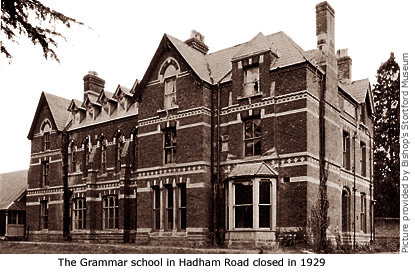 Not until the appointment in 1849 of Rev Francis Rhodes as Vicar of St Michael's, did a revival of the Grammar school become a possibility. Initially he had joined a committee formed by local Anglican churchmen and non-conformists, whose aim it was to unite and build a non-sectarian Propriety school for the town. But when Rhodes's attention was drawn to the old foundations of the former Grammar school in High Street, he left the committee in 1850 to put all his energies into refounding the school. Not until the appointment in 1849 of Rev Francis Rhodes as Vicar of St Michael's, did a revival of the Grammar school become a possibility. Initially he had joined a committee formed by local Anglican churchmen and non-conformists, whose aim it was to unite and build a non-sectarian Propriety school for the town. But when Rhodes's attention was drawn to the old foundations of the former Grammar school in High Street, he left the committee in 1850 to put all his energies into refounding the school.
One of the committee's founding members, Rev Hurndall of the Congregational church in Water Lane, went on to establish a new non-sectarian school (See Guide 5). But in the meantime Rhodes formed his own committee, raising enough funds to build a new schoolhouse on the site of the old Grammar school. This he named the High School. The Bishops of Rochester and London gave able assistance and patronage to the scheme, and it was liberally subscribed to by local people. To add to the funds the entire collection of library books from the former Grammar school, housed in the church tower since 1824, were sold. Earlier historians have suggested the books were sold to the Bodleian Library at Oxford, but no record of the transaction or of the books exists there.
Rhodes then secured the services of parish curate Dr Godfrey Goodman to act as headmaster, and while the new school was being built gave up the spacious vicarage in Church Street so that boarders and master might be housed in the interim period. He then moved his family to Netteswell House, a semi detached premises in South Road about a mile from the church (See Guide 13).
The school commenced at the vicarage in February 1850 with just three pupils, but by the time the new schoolhouse opened on 16 July 1850 that number had increased to thirteen. Additional finance came from the Margaret Dane Foundation, reconstituted in 1851, although by this time the original £5 bequest, paid annually, had been reduced to £2.10s. (£2.50p). However, with its reputation firmly re-established the school was enlarged within three years, many of its scholars being accommodated in a building at Hadham Road on land used by the school as their playing fields. The additional classrooms cost £226.
Six of Rhodes's sons attended the school at High Street; two of them, Herbert and Frank, going on to public schools. It was here also that Rhodes's youngest son, Cecil, began his education in 1862. Further increases in pupils forced a temporary move to Brook House in Rye Street (See Guide 7 - Brook House) until a decision was made to build much larger premises at Hadham Road. Accommodating some 70 boarders and costing £4,500, it was opened in 1860 under the headmastership of Rev Goodman. His success was soon reflected in the school's academic record, which proved to be every bit as good as it had been under headmasters Leigh and Tooke.
When Rev Goodman died, a chapel was erected alongside the school in 1893 to his memory, and remains the only part of the original building that still stands (See Guide 5 – Hadham Road). In later years the school changed its name from High School back to Grammar School, but from the early 1900s was more popularly known as the Bruce-Payne school – an affectionate reference to the long serving and well respected headmaster Mr J. Bruce-Payne, who took up the post in January 1904. Originally from Lowestoft in Suffolk where he had been headmaster of St Aubyn's school, his popularity there is shown by the fact that when he moved to Stortford he brought with him 80 boarders. But, as good as he was, academic competition from the newly formed Bishop's Stortford College severely dented the Grammar school's pupil intake and a lack of finance eventually forced its closure. The Grammar school is thought to have merged with the college in 1929.
Cecil Rhodes, who attended the original High School, died in 1902 but because of a 'presumed' falling out with the town of Bishop's Stortford over its treatment of his father, he left no part of his vast fortune to the school. Instead he bequeathed £3 million to Oxford University to establish the Rhodes scholarship trusts, enabling overseas students to attend the university and so promote 'the union of the English-speaking people throughout the world'. The Rhodes Trust did, however, later provide two scholarships to the College worth £20 a year. MORE PICTURES
|
|
Although the creation of the town's Grammar school is generally attributed to a bequest by Margaret Dane, it was her husband William Dane who was connected with Bishop's Stortford.
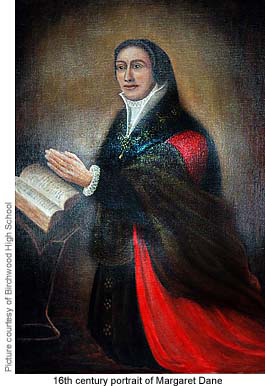 He was born in the town in 1517 to parents John Dane and Alice (nee Peppercorne). They also had a daughter, Helena, who was probably younger than William. There is little evidence of William's father but St Michael's records note work done by John Dane, locksmith, in 1499, and again in 1506 when John Dane is referred to as a farrier. This may have been the same person or one of them may have been William's grandfather. He was born in the town in 1517 to parents John Dane and Alice (nee Peppercorne). They also had a daughter, Helena, who was probably younger than William. There is little evidence of William's father but St Michael's records note work done by John Dane, locksmith, in 1499, and again in 1506 when John Dane is referred to as a farrier. This may have been the same person or one of them may have been William's grandfather.
It does, however, indicate a family of tradespeople whom, though not rich, earned sufficient money to pay £10 for 15 year-old William to go to London and serve as an apprentice ironmonger. At that time apprentice tradespeople had to pay to be trained. After William completed his seven year apprenticeship in 1539 he became a Freeman of the Company of Ironmongers, able to earn wages as a journeyman or start up his own business.
At about this time he met Margaret Kempe, daughter of a rich member of the Company of Mercers. After a brief courtship they married in the parish church of St Michael, Bassishaw, London, on 12 May 1542. The church was destroyed in the Great Fire of London (1666) but the registers were preserved. (A plaque on the north side of Guildhall marks its former site.)
Margaret Kempe came from a line of country gentlemen who owned the estate of Ollantigh, near Wye in Kent. Her Grandfather was Sir Thomas Kempe, three times Sheriff of Kent; his uncle had been Thomas Kempe, Bishop of London (1450–1489), and his great uncle, John Kempe, had twice been Lord Chancellor of England (1426–1432 and 1450–1452), and Archbishop of Canterbury (1452–1454).
Her father Edmond Kempe was the eldest of eight children. He came to London, went into commerce and was a member of the Company of Mercers. Her mother Bridget, formerly Bridget Style, also came from merchant stock and had been married before. Margaret's privileged background ensured she was well educated, whereas William came from a much lower social status. His schooling in Bishop's Stortford would have been basic: reading, writing and arithmetic and perhaps a little Latin. It was an odd partnership and her father seems to have been in disagreement with the marriage. When he died shortly after the wedding, he left nothing to either of them.
William became one of the leading merchants in the City, though what his actual business was is unclear. He should have been making iron goods but there is every indication that he dealt in the haberdashery and wholesale cloth trade. William and Margaret Dane lived in the parish of St Margaret Moses, London, possibly in Friday Street.
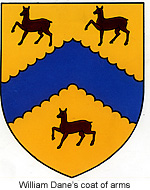 In 1556 he belonged to the Yeomanry of the Company of Ironmongers (i.e. a junior member), and in 1559 became a full Liveryman. In 1561 William applied for and was granted his own coat of arms. After being elected as Alderman for the Tower Ward in 1568, he was ever after known as Mr Alderman Dane. in 1569 he was both Master of the Company of Ironmongers and Sheriff of London, and in 1573 was once again elected Master of the Company. He died while in office and was buried in the parish church of St Margaret Moses. William and Margaret remained childless throughout their marriage. In 1556 he belonged to the Yeomanry of the Company of Ironmongers (i.e. a junior member), and in 1559 became a full Liveryman. In 1561 William applied for and was granted his own coat of arms. After being elected as Alderman for the Tower Ward in 1568, he was ever after known as Mr Alderman Dane. in 1569 he was both Master of the Company of Ironmongers and Sheriff of London, and in 1573 was once again elected Master of the Company. He died while in office and was buried in the parish church of St Margaret Moses. William and Margaret remained childless throughout their marriage.
In his will he made bequests to relatives, though their were few, and to the great hospitals St Thomas' and St Bartholomew’s. But it was to the poor that he left most. This included money to prisoners in all the main London prisons in order that they might buy food, and a special bequest to those that remained in prison so that they might pay their gaolers'. Prisoners not only had to buy their own food, they also had to pay for the gaolers' services. He also left money to young men of the Company of Ironmongers to help them start out in business and money to poor scholars at Oxford and Cambridge who studied divinity.
Although William never again lived in Stortford after he left at the age of 15, he did retain affection for the town. In his will he refers to Bishop's Stortford 'where I was born'. Perhaps because of this he left £50 towards the setting up of a school in Bishop's Stortford 'to teach poor men's childrens that they be brought up in the knowledge of God'. The school was to be specifically for the children of poor men and widows and was to be in the charge of a good scholar 'that feareth God'. He wanted the school to be set up within two years of his death with the help of some of the 'most substantiallist men in the townshippe'. But six years later, at the time of Margaret's death, the school still had not been built. It is no surprise that the school was not set up within two years of William's death, as he requested, because wills were not carried out very quickly. What isn't known is if William's £50 was ever used as intended.
He also left £5 to the prisoners in the town gaol and £20 to the poor of the town, with specific instructions as to its distribution. At Christmas and in Lent, £5 was to be distributed amongst the poorest people at the rate of twelve pence a head; twenty shillings was to be given on Easter Day to twenty poor people, and sixpence was to be given to forty poor men and women every Sunday after that until the whole sum had been disbursed.
Margaret Dane's ability as a businesswoman is confirmed by the fact that she carried on William's business for six years after his death. She had many contacts in the City of London, as well as with merchants in Bristol and Newcastle. She was also well acquainted with the Royal Household and many notable names from the reign of Elizabeth I. When Margaret died in 1579 she left the Queen a gold necklace worth £200.
To the Company of Ironmongers she left £2,000. Of this, the sum of £100 was to be lent to young men starting out in business for a maximum of three years, though she specified dealers in linen cloth were to be preferred. Interest on the total £2,000 was to be used for charitable purposes, which included annual donations to hospitals, prisons, and the poor of the parish where she had lived. Scholarships were to be founded at Oxford and Cambridge.
She then turned her attention to Bishop's Stortford. £20 was to be paid to the poor of the town, £5 within forty days of her death and a further £5 each quarter until the whole was paid. More importantly, £5 a year from the interest on the £2,000 was to be paid for a school yet to be erected in the town. If the school was not built, then the money was to go to the poor.
Her legacy did not come into the hands of the Company of Ironmongers until 1602, 23 years after her death. The company lent out the capital until 1647 when the Civil War intervened. Company books of 1748 say the money was taken by parliament and sundry lords during the Civil War, and never repaid. Despite this the various bequests were paid out fairly regularly, and in the 19th century were tidied up in the general enquiry into local charities.
When a school was eventually founded in Bishop's Stortford in the 17th century, the sum of £5 was paid out several times. According to the Schools' Enquiry Commission of 1864, the name of the founder was unknown but Margaret Dane was the first benefactress.
*Information taken from 'In Search of Margaret and William Dane' by Sheila Ormerod, courtesy of James Oliver, Clerk of The Ironmongers' Company. Picture of Margaret Dane is courtesy of Birchwood High school, formerly Margaret Dane school.
|




 The dilapidated school and gatehouse referred to by churchwardens' was very likely a Church School, built in the mid 14th century on, or close to, the corner of Church Street and High Street and adjoining the churchyard.
The dilapidated school and gatehouse referred to by churchwardens' was very likely a Church School, built in the mid 14th century on, or close to, the corner of Church Street and High Street and adjoining the churchyard. The town was also badly in need of a new market place at this time, and so a scheme sanctioned by the commissioners was put forward that would serve a dual purpose. In 1699, preparations were made to construct Wheathill Market House on the site of the old school at the corner of Church Street and Wheathill (now High Street). The ground floor was to house market stalls and shops while above them, raised on wooden arches, would be the new Grammar school comprising of three rooms – the school overlooking Wheathill (High Street) and a Writing school and library positioned on the opposite side of the building facing south.
The town was also badly in need of a new market place at this time, and so a scheme sanctioned by the commissioners was put forward that would serve a dual purpose. In 1699, preparations were made to construct Wheathill Market House on the site of the old school at the corner of Church Street and Wheathill (now High Street). The ground floor was to house market stalls and shops while above them, raised on wooden arches, would be the new Grammar school comprising of three rooms – the school overlooking Wheathill (High Street) and a Writing school and library positioned on the opposite side of the building facing south. Not until the appointment in 1849 of Rev Francis Rhodes as Vicar of St Michael's, did a revival of the Grammar school become a possibility. Initially he had joined a committee formed by local Anglican churchmen and non-conformists, whose aim it was to unite and build a non-sectarian Propriety school for the town. But when Rhodes's attention was drawn to the old foundations of the former Grammar school in High Street, he left the committee in 1850 to put all his energies into refounding the school.
Not until the appointment in 1849 of Rev Francis Rhodes as Vicar of St Michael's, did a revival of the Grammar school become a possibility. Initially he had joined a committee formed by local Anglican churchmen and non-conformists, whose aim it was to unite and build a non-sectarian Propriety school for the town. But when Rhodes's attention was drawn to the old foundations of the former Grammar school in High Street, he left the committee in 1850 to put all his energies into refounding the school. He was born in the town in 1517 to parents John Dane and Alice (nee Peppercorne). They also had a daughter, Helena, who was probably younger than William. There is little evidence of William's father but St Michael's records note work done by John Dane, locksmith, in 1499, and again in 1506 when John Dane is referred to as a farrier. This may have been the same person or one of them may have been William's grandfather.
He was born in the town in 1517 to parents John Dane and Alice (nee Peppercorne). They also had a daughter, Helena, who was probably younger than William. There is little evidence of William's father but St Michael's records note work done by John Dane, locksmith, in 1499, and again in 1506 when John Dane is referred to as a farrier. This may have been the same person or one of them may have been William's grandfather. In 1556 he belonged to the Yeomanry of the Company of Ironmongers (i.e. a junior member), and in 1559 became a full Liveryman. In 1561 William applied for and was granted his own coat of arms. After being elected as Alderman for the Tower Ward in 1568, he was ever after known as Mr Alderman Dane. in 1569 he was both Master of the Company of Ironmongers and Sheriff of London, and in 1573 was once again elected Master of the Company. He died while in office and was buried in the parish church of St Margaret Moses. William and Margaret remained childless throughout their marriage.
In 1556 he belonged to the Yeomanry of the Company of Ironmongers (i.e. a junior member), and in 1559 became a full Liveryman. In 1561 William applied for and was granted his own coat of arms. After being elected as Alderman for the Tower Ward in 1568, he was ever after known as Mr Alderman Dane. in 1569 he was both Master of the Company of Ironmongers and Sheriff of London, and in 1573 was once again elected Master of the Company. He died while in office and was buried in the parish church of St Margaret Moses. William and Margaret remained childless throughout their marriage.